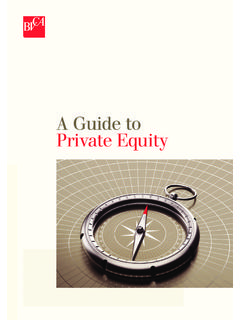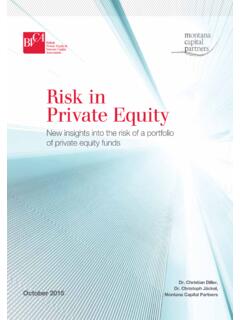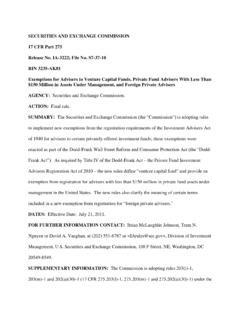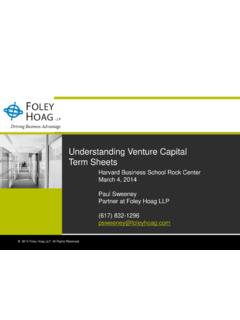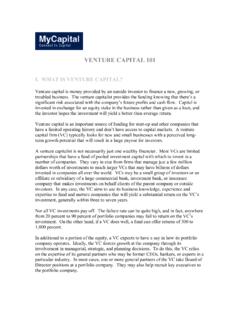Transcription of A Guide to Private Equity
1 A Guide to Private Equity 1xxxxxA Guide to Private Equity 2 A Guide to Private Equity xxxxxA Guide to Private Equity 1 BVCA mission statementTHE BVCA is the industry body and public policy advocate for Private Equity and venture capital in the UK, an industry that accounts for almost 60% of the European market. With a membership of over 450 members, the BVCA represents an overwhelming majority of UK-based Private Equity and venture capital firms and their advisers from venture capital , through mid-market, to Private Equity /large buy-out over 26 years, the BVCA s voice has been one of authority when speaking for, or negotiating on behalf of, the UK industry to a wide range of key stakeholders: government, the European Commission and Parliament, media and statutory bodies at home, across Europe and globally.
2 We also promote our members services to entrepreneurs and investors, as well as providing valuable research, training and networking opportunities to our members of the BVCA are listed in our annual Directory of Members . Other publications include reports and analysis produced by our Research team, such as the annual Performance Measurement Survey and the Report on Investment Activity. All publications are available on the BVCA website: A Guide to Private Equity Private Equity investing in Britain s future Each year UK Private Equity firms provide billions of pounds to form, develop and reshape over 1,600 ambitious UK companies with high growth prospects.
3 Private Equity makes managers into owners, giving them the freedom, focus and finance to enable them to revitalise their companies and take them onto their next phase of growth. Private Equity is committed, long-term and risk sharing. It provides companies with the personal experience of the investors and a stable financial base on which to make strategic decisions. UK Private Equity firms offer a wide range of sources, types and styles of Private Equity to meet many different needs. A great variety of businesses in different industry sectors benefit from Private Equity ; including those operating in the high technology, industrial, healthcare, consumer services, financial and other sectors, and in different development stages from start-up to large established companies.
4 A Guide to Private Equity 3 Preface The BVCA is the industry body and public policy advocate for the Private Equity and venture capital industry in the UK. With a membership of over 450 firms, the BVCA represents the vast majority of all UK-based Private Equity and venture capital firms and their advisors. A Guide to Private Equity is a key component in the range of BVCA publications. For further details about other BVCA publications and research see the Appendix on page 50 or the BVCA s website Arundale, formerly with PricewaterhouseCoopers LLP and now a university lecturer and independent adviser, suggested that the BVCA should have a Guide to Private Equity which demystified the investment process - so he was duly asked to write it!
5 The first Guide was published in 1992 and since then many tens of thousands of copies have been sent out or downloaded from the BVCA s website. This new edition has again been updated by Keith, including the section on government sources of finance and new sections on specific considerations relating to venture capital and management buyout deals, term sheets and the working relationship between a Private Equity investor and management team. I would like to thank Keith for initiating the Guide and for his continuing help over the years. I would also like to thank the BVCA Executive for the production of another excellent Guide . Simon HaversBVCA ChairmanFebruary 20104 A Guide to Private Equity ContentsBVCA mission statement 1 Private Equity investing in Britain s future 2 Preface 3An introduction to Private Equity 6 Definition 6 How this Guide can help you 6 What is Private Equity ?
6 7 Would my company be attractive to a Private Equity investor? 7 Some of the benefits of Private Equity 7 Questions to ask yourself before reading further 7 Internal and external financial resources 8 Government sources of finance for SMEs and growing businesses in the UK 8 Business angels 11 Corporate venturing 11 Investment forums and networking organisations 11 Well-know Private Equity backed companies 12 The advantages of Private Equity over senior debt 12 Private Equity compared to senior debt 13 Sources of Private Equity 14 Private Equity firms 14 Where do Private Equity firms obtain the money to invest in my business? 14 How may the source of a Private Equity firm s money affect me? 14 How do I select the right Private Equity firm?
7 15 Selecting a Private Equity firm 16 Targeting 16 Stage / type of investment 16 Industry sector 17 Amount of investment 17 Geographical location 18 The business plan 19 Essential areas to cover in your business plan 19- The market 20- The product or service 21- The management team 22- Business operations 22- Financial projections 23- Amount and use of finance required and exit opportunities 24 The presentation of your business plan 24 Things to avoid 25 A Guide to Private Equity 5 ContentsThe investment process 26 Reaching your audience 26 Confidentiality 26 How quickly should I receive a response?
8 26 How do Private Equity firms evaluate a business plan? 26 Presenting your business plan and negotiations 27 Valuing the business 27 Personal financial commitment 29 Types of financing structure 29 Classes of capital used by Private Equity firms 29 Other forms of finance provided in addition to Equity 30 Additional points to be considered 30 Specific considerations relating to venture capital and management buyout deals 31- How a venture capitalist arrives at his required Equity stake 31- Use of preference shares in structuring a venture capital deal 31- Management buyouts 32 The Offer Letter (Term Sheet) 34 The due diligence process 37 Syndication 38 Completion 38 Additional Private Equity definitions 38 The role of professional advisers 40 The financial adviser s role 40 The accountant s role 40 The lawyer s role 41 Professional costs 42 Your relationship with your investor 43 Private Equity for growth and success 43 Hands-on approach 43 Hands-off approach 44 Help to avoid the pitfalls 44 Tips for working with your Private Equity investor 44 Directors
9 Responsibilities 45 Guidelines for success 45 Realising the investment 46 The options 46 Valuing the investment on exit 47 Before you do anything read this! 48 Legal and regulatory issues you must comply with in raising finance 48 The Financial Services and Markets Act 48 Misleading statements 49 Appendix further information 50 Contact details 50 BVCA publications and research 51 Other useful contacts 526 A Guide to Private Equity An introduction to Private Equity Definition Private Equity is medium to long-term finance provided in return for an Equity stake in potentially high growth unquoted companies. Some commentators use the term Private Equity to refer only to the buy-out and buy-in investment sector.
10 Some others, in Europe but not the USA, use the term venture capital to cover all stages, synonymous with Private Equity . In the USA venture capital refers only to investments in early stage and expanding companies. To avoid confusion, the term Private Equity is used throughout this Guide to describe the industry as a whole, encompassing both venture capital (the seed to expansion stages of investment) and management buy-outs and buy-ins. How this Guide can help you This Guide aims to encourage you to approach a source of Private Equity early in your search for finance. It explains how the Private Equity process works and what you need to do to improve your chances of raising it. It gives guidance on what should be included in your business plan, which is a vital tool in your search for funding.

